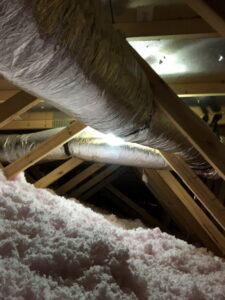 It would be a challenge for you to find a homeowner in our area who doesn’t care how efficiently their air conditioner operates. Given how much of our cooling that we use every year, it makes sense that when the time comes to start using it again in the spring, we want to do so as affordably as possible.
It would be a challenge for you to find a homeowner in our area who doesn’t care how efficiently their air conditioner operates. Given how much of our cooling that we use every year, it makes sense that when the time comes to start using it again in the spring, we want to do so as affordably as possible.
What many folks don’t think about, however, is the role that the “V” part of “HVAC” plays. V stands for ventilation, and your ductwork makes up the ventilation system, connecting your forced-air HVAC systems to the outdoors, making the distribution of conditioned air possible.
Ductwork is often out of sight, and therefore out of mind—behind walls or in attics and crawlspaces. So it’s not easy for you to see when and if it’s damaged… but what can happen if it is damaged?
What Damaged Ductwork Looks Like
Aging ductwork can eventually fall prey to things like leaks and tears. It can even accumulate damage if it wasn’t installed correctly to begin with and has poor connections or construction. One of the most common installation mishaps that leads to damaged ductwork is improperly sized ductwork, which we’ll talk more about below.
When Ducts Aren’t Sized Correctly
First off, when ductwork isn’t properly matched to the air conditioner, furnace, or heat pump its connected to, you’ll probably realize it right away, since the HVAC system will be noisy due to the restriction or blockage of airflow. Unfortunately, however, too many folks just accept this noise, even though it’s a sign of a problem.
When air ducts are too large for the space and for the system they’re installed with, it causes a reduction in airflow, which results in uneven temperatures throughout the living space, since conditioned air won’t be able to reach all the vents. Studies show that improper duct sizing and design can lead to as much as 30% cooling loss from your HVAC systems.
This puts extra strain on your HVAC systems, causing them to work inefficiently and wasting energy to boot. Your HVAC system will struggle to reach the desired temperature set on your thermostat, and your system will start accumulating damage faster than it otherwise would have. You could find yourself facing premature AC or furnace replacement as a result.
Other Causes of Ductwork Damage
Improperly sized and installed ductwork is not the only reason ducts get damaged. Ductwork can accumulate tears and such from rodents in the crawlspace or attic, construction or repairs done around the area of your ductwork, and even intensely hot temperatures in the summer as the sun beats down on your roof—if your ducts are in the attic.
Fortunately, we’re here to help with whatever your ductwork problems are. And don’t forget to schedule maintenance with our team too—during maintenance we inspect every component of your HVAC systems to ensure they’re working as they should. And this includes your ductwork!
Contact Wall Heating & Air Conditioning, Inc. today for quality HVAC services in Lawrenceville, GA.
